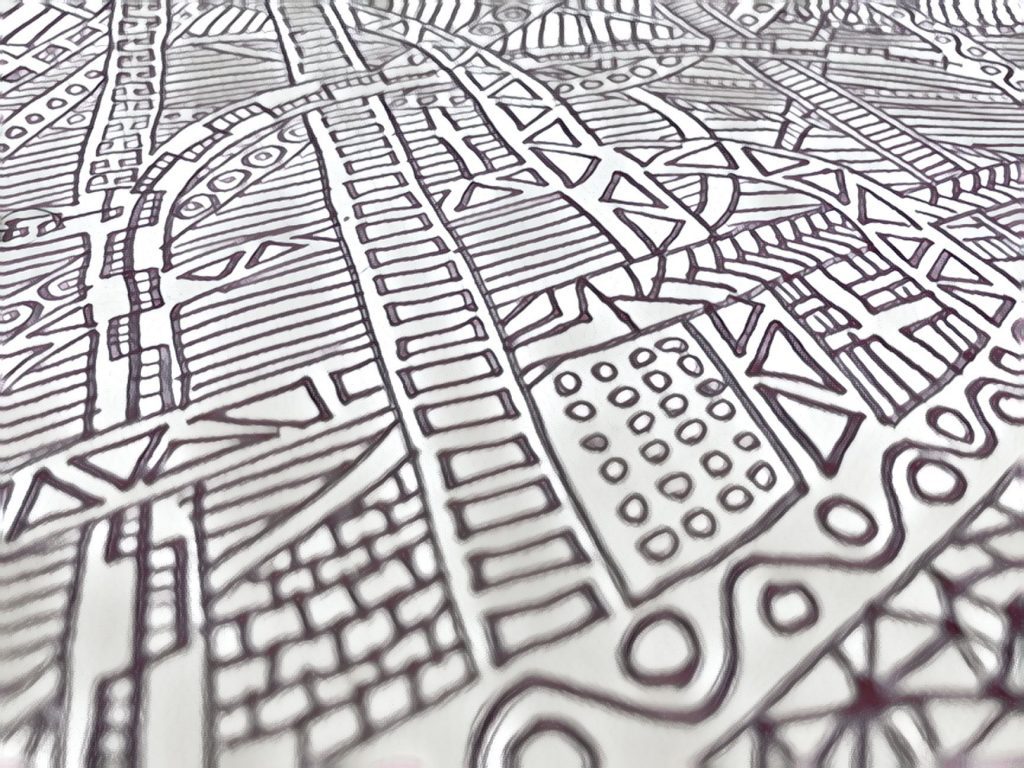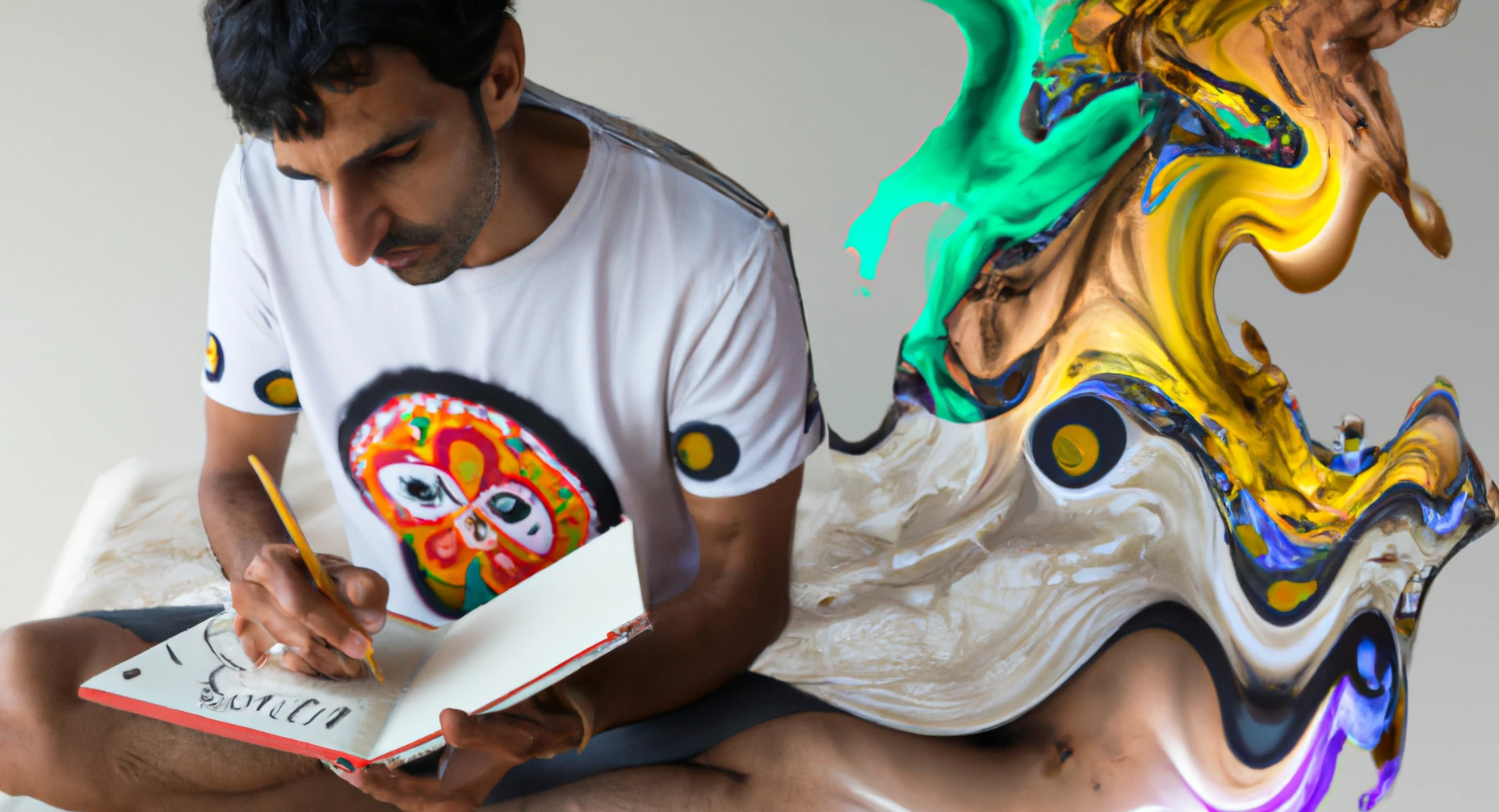You become creative by practicing creativity consistently. And a creative journal will build your creative muscles day after day. You’ll become a more confident artist and develop deeper trust in your own abilities.
In this article we’ll cover what a creative journal is, why it’s worth doing, how to find the right way of doing it for you, choosing the right journal format, and more—in short, everything you need to know to begin your creative journaling journey.
What is a creative journal?
A creative journey is not a diary. It’s not a place where you write down your experiences of the day, nor your thoughts and emotions. Instead, it’s a daily creative practice that can take many forms. It’s a place where you can exercise your creativity. Think of it more as art journaling than a traditional journal, a bridge between the realm of your imagination and the real world.
Next we’ll cover reasons why you should keep a creative journal, explore different creative journaling ideas(from the written word to doodles to photos, collages, and many other forms of creative expression), and how to go about choosing the right creative journal for yourself.
Benefits of creative journaling
There are many reasons why you might want to start a creative journal:
- Nurture your creativity.
The daily practice will help you develop your creative potential and access inner resources of higher wisdom. - Brainstorm.
You can enhance your creative problem-solving skills by thinking up new ways to tackle challenging problems and come up with fresh ideas. - Overcome creative procrastination.
Every creative has struggled with creative blocks, and it can be tempting to wait for a better time. Building a daily habit of creative engagement helps you stop procrastinating and start creating. - Expand your creative skills.
Your journal can be a great practice ground to try out new things without requiring you to invest much time or effort into it. - Capturing ideas you don’t act on now, but might want to revisit in the future.
If you’re an idea machine, you have many more ideas than you can make happen. Having a place where you capture them makes it easier to say “no” to ideas that seem too good to pass on, while ensuring that they don’t get lost in the fog of time. - Improve mental health and well-being.
Psychologists and researchers have studied the benefits of creative journaling and found that it can help release trapped feelings, help with creative expression, support the healing process of trauma therapy, and more.
How to journal creatively
First, there’s no right way when it comes to journaling creatively. You create your creative journal exactly the way you want it. One thing I love about creative journaling is that it requires absolutely no organization, and I can literally do whatever I want. I open a new page and start creating. Whatever journaling technique I’m inspired to use on any given day: on some days that means I write, on other days I doodle, on other days I draw or I make a collage, or I mind-map.
Freewriting
I’m a big fan of freewriting and do it every day. It’s very simple: You just write whatever is on your mind. You keep the words coming, and if you don’t know what to write about, you write that! Here’s an example: “I don’t know what to write about, but I’m gonna keep writing, because eventually something will come out of this. And even if not, I’ll keep writing that I don’t know what to write about until my brain is so bored with it that it’ll throw some ideas to write about my way.”
If I have any vivid or intense dreams, I like to write about those like in a dream journal.
The point of freewriting is not to create great writing—it’s simply to overcome writer’s block and get you into a creative flow.
Creative bullet journal
You can also use bullets to jot down ideas. In fact, one of my most common journal entries are simply bulleted lists of creative ideas. I essentially use these as brainstorming sessions, and by always keeping these in one book, I never have to worry about losing a good idea.
Writing prompts
Want to jumpstart an idea on what to write about? Writing prompts are great for doing that. A journal prompt can be a simple question like:
- What do you feel excited about?
- What makes you sad?
- What makes you angry?
- What are you grateful for? (Yes, it’s absolutely fine to also use it as a gratitude journal.)
- What was the most interesting scent you smelled today? (You can ask the same question for different sensory channels.)
There are many more writing prompts, and especially if you’re doing creative writing or write short stories, check out some of the Writing Prompts subreddit, and if you prefer prompts more focused on personal journaling, Kate Arends put together a great selection of journaling prompts that will help you build your creative writing skills.
Doodle like you mean it

I have a habit of doodling abstract random lines and shapes, especially when I listen to an audiobook or podcast. Doodling engages the brain’s default mode network, which is conductive to both better memory recall, increased creativity. Many doodlers also find that doodling helps them relax (which might explain why 26 out of the first 44 US presidents doodled—many of these presidential doodles can be found in David Greenberg’s book).
Definitely doodle in your creative journal when you feel like it.
Use colors
Using many colors will make your creative journal more, well, colorful. It’ll also be a lot more fun when one day in the future, you review your past entries. Colors are also a powerful means of emphasizing different ideas or concepts in writing. I have different colored felt tip pens I use when I’m feeling colorful. I like them because the colors are strong and vivid.
Draw & paint
If you enjoy drawing and painting, by all means, use your creative journal as an outlet for these impulses. I recommend you keep it simple, but you can go as elaborate as you want. The main idea is to not focus on the result, but on the process: you want to get your creative juices flowing. So definitely turn off your inner critic, and treat your creative journal like a sketchbook.
Make a collage
A collage can be a great way to blur the lines between reality and fantasy. You can absolutely turn your creative journal into a scrapbook. Photos, stickers, a bit of packaging of something that you bought, a movie ticket, a handwritten note you got from someone, a receipt, a piece of packaging, a business card, all these are materials that you can use to represent a specific thing or place and make it the basis of your daily creation.

You can also attach a sheet of paper to your notebook that you can unfold if you want more space for a particular page. I love using flight tickets or postcards from places I’ve been to and sometimes use my creative journal as a travel journal.
Create your focus zone
When you’re doing your creative journaling, you want to be i a focused state of mind, without getting distracted. So turn off your phone notifications, and even better: put your phone somewhere else, so you’re not even tempted. If you’re living with someone else, close the door and put a sign in front of the door that you don’t want to be disturbed.
Write poems
Whether you write your own poems or write down verses from a poem you love and illustrate it in your own way, poems are a wonderful way of crossing over into the realm of the creative through the written word.
Listen to music
Music that can put you in a positive mood can foster creativity and divergent thinking.
“For breakthrough moments of creativity, positive mood is generally helpful”
—Mark Beeman, chair of psychology at Northwestern University and principal investigator at NU’s Creative Brain Lab, Time Magazine
I have my own creative playlist that helps me get in the right mood, and while I don’t use it daily, music accompanies probably half of my creative journaling sessions. It really depends on how I feel. Mostly on days where I’m in a naturally more focused and creative mood already, I don’t listen to music during my creative journaling, but when I’m not quite feeling it, and my mind is a bit all over the place, it actually helps me to put on some music.
How often should you review past journal pages?
The choice is all yours. Maybe you want to do this once a month, or a week, or a quarter, or you just do so whenever you feel like it. I find a monthly review is a nice cadence for me, since the ideas I come across are still somewhat fresh on my mind, and I’m more likely to act on them or relate to them than on an idea I had six months ago or more.
What’s the best notebook or journal?
There are many creative journals, and again, it all depends on your personal preferences. I actually take a big A3 sheet, and use a simple B2 pencil on most days. Then I take a picture of the A3 sheet and file it away in an Evernote folder. I tear the real paper up and throw it away.
But many people will want to maintain a physical creative journal, and there are plenty of choices out there.
If you’re going to use a lot of colors or glues, then choose a strong enough paper so the colors won’t bleed through.
Want to buy your first creative journal? Find it on Amazon or Etsy.
You can also find printable templates online if you prefer a more guided journal:
- Journal templates by 101Planners.com
The site is pretty annoying because it’s heavily plastered with ads, but you can download free, printable journaling templates without having to enter your email. - Journal templates by Canva
You’ll need a (free) Canva account to use these templates, and some of them (the ones with a little crown symbol) are only available for paying subscribers, but even the free ones are good enough.
You can also check out Lucia Capacchione’s classic book The Creative Journal: The Art of Finding Yourself. This book, first published in 1980, is often referred to in art therapy circles, and provides plenty of examples and journaling prompts. (It’s available as Kindle book or paperback.)
BuzzFeed Nifty has a great video that can spark some creative journal ideas for you:
Journal writing is a great daily practice for creative people. Try it and let me know how it goes for you, and if you have questions, let me know in the comments below.
